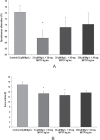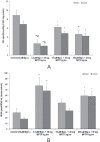CENTRAL AND PERIPHERAL EFFECT OF MPTP VIA DOSE-DEPENDENT MAGNESIUM MODULATION
- PMID: 37601708
- PMCID: PMC10439331
- DOI: 10.4183/aeb.2023.36
CENTRAL AND PERIPHERAL EFFECT OF MPTP VIA DOSE-DEPENDENT MAGNESIUM MODULATION
Abstract
Background: Recent studies suggested that MPTP could cause gastrointestinal motility deficits additionally to its nonconclusive and controverted effects on the CNS (behavior and brain oxidative stress) in rats. A possible interaction between MPTP typical impairments and magnesium modulatory potential was previously suggested, as magnesium role was described in neuroprotection, gastrointestinal function, and oxidative stress.
Aim: To investigate the possible modulatory effect of several magnesium intake formulations (via drinking water) in MPTP neurotoxicity and functional gastrointestinal impairment induction.
Materials and methods: Adult male Wistar rats were subjected to 3-week magnesium intake-controlled diets (magnesium depleted food and magnesium enriched drinking water) previously to acute subcutaneous MPTP treatment (30 mg/ kg body weight). Gastrointestinal motility (one hour stool collection test), and behavioral patterns (Y maze task, elevated plus maze test, open field test, forced swim test) were evaluated. Followingly, brain and bowel samples were collected, and oxidative stress was evaluated (glutathione peroxidase activity, malondial-dehyde concentrations).
Results: MPTP could lead to magnesium intake-dependent constipation-like gastrointestinal motility impairments, anxiety- and depressive-like affective behavior changes, and mild pain tolerance defects. Also, we found similar brain and intestinal patterns in magnesium-dependent oxidative stress.
Conclusion: While the MPTP effects in normal magnesium intake could be regarded as not fully relevant in rat models and limited to the current experimental conditions, the abnormalities observed in the affective behavior, gastrointestinal status, pain tolerance, peripheric and central oxidative status could be indicative of the extent of the systemic effects of MPTP that are not restricted to the CNS level, but also to gastro-intestinal system.
Keywords: MPTP; Parkinson’s disease; animal model; anxious behavior; depressive-like behavior; gastrointestinal; locomotor impairment.
©2023 Acta Endocrinologica (Buc).
Conflict of interest statement
The authors declare that they have no conflict of interest.
Figures








Similar articles
-
Glycine nano-selenium prevents brain oxidative stress and neurobehavioral abnormalities caused by MPTP in rats.J Trace Elem Med Biol. 2021 Mar;64:126680. doi: 10.1016/j.jtemb.2020.126680. Epub 2020 Nov 12. J Trace Elem Med Biol. 2021. PMID: 33242795
-
Ceftriaxone mediated rescue of nigral oxidative damage and motor deficits in MPTP model of Parkinson's disease in rats.Neurotoxicology. 2014 Sep;44:71-9. doi: 10.1016/j.neuro.2014.05.009. Epub 2014 Jun 2. Neurotoxicology. 2014. PMID: 25053526
-
Atorvastatin improves cognitive, emotional and motor impairments induced by intranasal 1-methyl-4-phenyl-1,2,3,6-tetrahydropyridine (MPTP) administration in rats, an experimental model of Parkinson's disease.Brain Res. 2013 Jun 4;1513:103-16. doi: 10.1016/j.brainres.2013.03.029. Epub 2013 Mar 30. Brain Res. 2013. PMID: 23548600
-
PPAR-α agonist fenofibrate protects against the damaging effects of MPTP in a rat model of Parkinson's disease.Prog Neuropsychopharmacol Biol Psychiatry. 2014 Aug 4;53:35-44. doi: 10.1016/j.pnpbp.2014.02.009. Epub 2014 Mar 1. Prog Neuropsychopharmacol Biol Psychiatry. 2014. PMID: 24593945
-
Chronic mild stress augments MPTP induced neurotoxicity in a murine model of Parkinson's disease.Physiol Behav. 2017 May 1;173:132-143. doi: 10.1016/j.physbeh.2017.01.046. Epub 2017 Feb 6. Physiol Behav. 2017. PMID: 28185878
References
-
- Eaker EY, Bixler GB, Dunn AJ, Moreshead WV, Mathias JR. Chronic alterations in jejunal myoelectric activity in rats due to MPTP. Am J Physiol. 1987;253(6 Pt 1):G809–815. - PubMed
-
- Riachi NJ, Dietrich WD, Harik SI. Effects of internal carotid administration of MPTP on rat brain and blood-brain barrier. Brain Res. 1990;533(1):6–14. - PubMed
-
- Lai F, Jiang R, Xie W, Liu X, Tang Y, Xiao H, Gao J, Jia Y, Bai Q. Intestinal Pathology and Gut Microbiota Alterations in a Methyl-4-phenyl-1,2,3,6-tetrahydropyridine (MPTP) Mouse Model of Parkinson’s Disease. Neurochem Res. 2018;43(10):1986–1999. - PubMed
LinkOut - more resources
Full Text Sources
